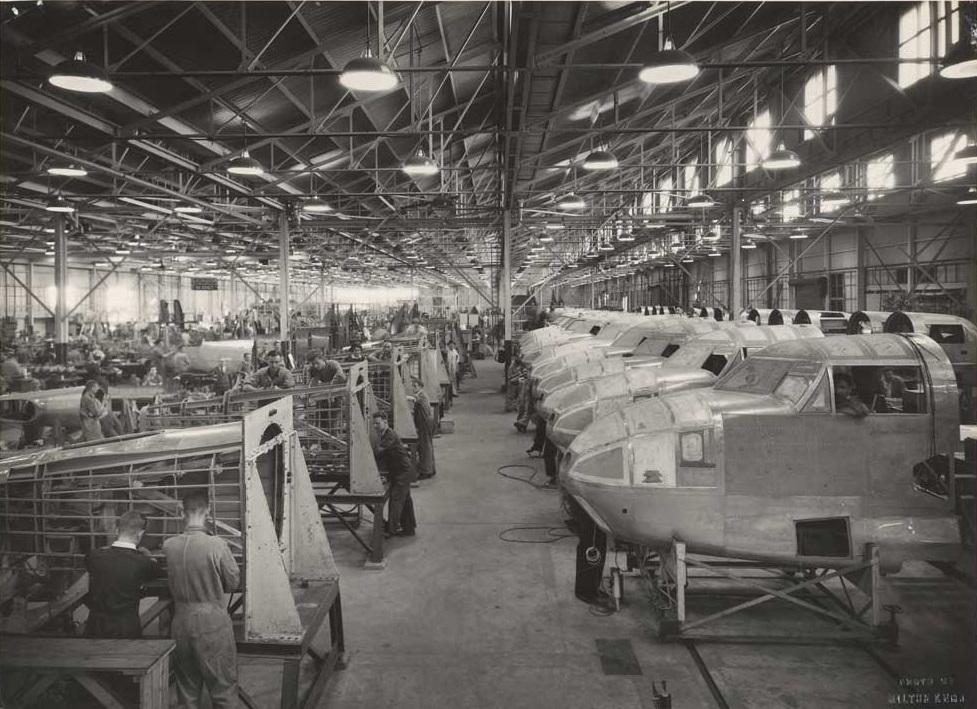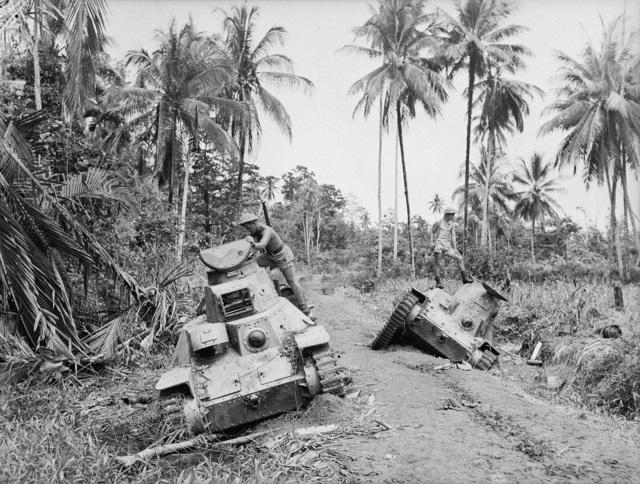The role of Australian industrial power in the defeat of Japan in World War II
Posted By Andrew Ross on August 15, 2020 @ 11:00

Today, on the 75th anniversary of the end of World War II, questions remain about what stopped the Japanese from invading Australia, and how it was that many of our personnel came home alive and unwounded despite the dreadful conditions they faced.
The answers largely define an achievement of Australia’s World War II generation.
Although Australia had thousands of airmen serving Britain in Europe and the Middle East, and three infantry divisions in Egypt and Palestine, these contributions to the British war effort were a down-payment for British protection against Japan, the only nation with the capability and intent to directly threaten Australia.
The fall of Britain’s defence shield, Singapore, to Japanese forces in mid-February 1942 has convinced Australians that their nation was left defenceless, and was only saved from invasion because of American assistance and a Japanese agenda to finish the war in China.
In reality, the opportunity to secure the southern flank, of all their conquests, would have been irresistible to the Japanese, and good military strategy. The only aid that Britain and the US were able to send was General Douglas MacArthur. No significant American forces reached Australia until well past that critical phase of the war (February to June 1942).
Something was happening in Australia that caused Japan to reject invasion, as it did in late February 1942. The opportunity to invade a defenceless Australia would never have looked more viable.
Australia had just completed its industrialisation in 1939. From 1919, Australian governments had fought off the determined efforts of the great economic powers to prevent that happening. But by combining with industrial companies such as BHP, and Collins House, and using its own technical organisations such as the Munitions Supply Board of the Department of Defence, Australia created the key industries required.
By December 1941, the nation had been in a full war economy for 18 months, and by March 1942 had created enough armaments to fully equip six infantry divisions. These units were equipped to fight German panzer divisions, and were twice as powerful as Japanese divisions and much more mobile. Their artillery was twice the strength of Japanese field artillery and outranged it. The Australian 2-pounder anti-tank guns outranged all Japanese tanks in Southeast Asia and could penetrate their armour, making it disastrous for any tank force.
The scale of Australia’s armament program is recorded in the monthly reports of the director-general of munitions and backed up by similar monthly reports from the army on what it was receiving from the department. Both were war cabinet documents. By June 1942, Australian production had equipped eight infantry divisions with modern weapons.
Having had diplomatic representation in Australia until December 1941, Japan was most likely well informed, in general terms, about Australia’s burgeoning industrial war economy, which, apart from its own, was unique in the Pacific and Southeast Asia.
In late February 1942, the Japanese army and navy discussed an invasion of Australia. Although the navy was enthusiastic, the army put forward a military appreciation which dismissed the idea as far too dangerous.
It recognised that Australian forces were likely to be better armed than the Japanese divisions, and more mobile. The appreciation said an invasion would require a minimum of 12 divisions. This force could not be provided from existing resources without weakening Japan’s hold on its conquests, and it might still be defeated by the aggressive Australians defending their homeland. The Japanese army rejected the navy’s suggestion. The idea was never considered seriously again by the Japanese.
Australian scientists, technocrats and industrialists had created so much equipment that Japan could not supply the volumes of its own materiel to overcome it. Japanese airpower could not redress this imbalance because it had not developed effective close air-to-ground support for its troops and had to face heavy Australian anti-aircraft defence. The Japanese were also aware that Australian strength in fighter aircraft was increasing steadily, and that radars were spread up the east and north coasts of Australia. Thus, Australia’s greatest strategic victory in World War II was achieved by science, technology and secondary industry.
The US naval victory at the battle of Midway, in early June 1942, removed the Japan’s capability to invade Australia by destroying its main aircraft carriers. This made it safe for Australia to begin to transfer military power to fight the Japanese in Australian Papua and New Guinea. Australia had to re-equip its army to cope with the corrosive jungle environment and extremely steep and rugged terrain. The battles took place in terrible conditions, which should have favoured the Japanese defenders. A stalemate was the most likely result, with heavy casualties on both sides, which the Japanese were willing to accept.
The early battles followed this pattern. But Australia had organised its scientific and technical resources far more efficiently than Japan. By mid-1943, Australia had become, for the allies, the centre of research into jungle organisms and jungle-proofing of all weapons and equipment. A flood of new equipment, specially treated clothing and food, and a vastly superior medical support system with Australian-made drugs and antibiotics swung the struggle in the jungle decisively in Australia’s favour.
Japanese battle casualties in the Southwest Pacific inflicted by the Australians were well over 50,000, whereas Australian battle casualties were 14,700. Japanese deaths from disease and starvation in the same area were over 100,000. Australian deaths from the same causes were about 1,000.
At this ratio of 1:3, Australian battle losses were the opposite of the classical ratio for an attacking force encountering a well-prepared defence, in rugged, well-covered terrain. The Australians reversed this loss ratio through better-designed weapons, better communications, better-quality ammunition and flexible battle tactics. Japanese weapons were poorly designed for jungle warfare in equatorial regions, their ammunition and communications were degraded by jungle organisms, and their battle tactics were often inappropriate for the conditions and terrain in which they fought.

The extraordinary imbalance in deaths caused by disease and starvation was a direct consequence of the Japanese army’s lack of logistic and medical support for its troops. Before World War II, Japan had conducted nearly all its campaigns in well-populated and productive environments such as China and Manchuria. These environments were not particularly unhealthy, so it could get away with a rudimentary medical system. Similarly, food could be taken from the local populations, so Japanese forces did not need an elaborate logistic support system.
When Japan began its Kokoda campaign, it needed to sweep away the opposition quickly, before disease took hold in Japanese troops and they exhausted their rudimentary food supplies. They could not rely on getting food from the sparse local population.
Although it took some time to organise, by early 1943 the Australian logistic system provided good medical support and increasing amounts of food.
The result was devastating, because nearly all of Japan’s post-Kokoda campaigns in Southeast Asia were conducted in jungle environments with sparse populations, which dramatically exposed logistic and medical deficiencies.
The impact of Australian science, technology and secondary industry on the survivability of Australian troops can be calculated roughly. Australian forces might have expected a minimum of around 45,000 casualties, given that they were trying to drive the Japanese out of very formidable defensive positions. If the Japanese had been able to prolong their resistance, this would have produced a situation like many World War I campaigns and caused Australian casualties as high as 80,000. The impact on Australia would have been enormous.
Australia’s war economy also provided vast amounts of clothing to hundreds of thousands of American service personnel in the Southwest Pacific. Huge quantities of basic materials for road and base building, as well as armaments, transport and signal equipment, were also supplied. In 1943, Australia supplied 95% of the food for 1,000,000 American servicemen. In commenting on this wartime support, President Harry Truman wrote in his 1946 report to the US Congress on the Lend-Lease Act, ‘On balance, the contribution made by Australia, a country having a population of about seven millions, approximately equalled that of the United States’.
This extraordinary result highlighted the monumental achievements of Australia’s World War II generation. Clearly, Australian governments of the 1930s regarded defence preparations as being more than the accumulation of armaments, which then rapidly became obsolete. They chose to put their effort into the development of secondary industry, which advanced national development and immigration, but also provided a huge amount of flexibility in what could be produced to arm the nation in an emergency.
They did this in a way that deserves much greater recognition.
Article printed from The Strategist: https://aspistrategist.ru
URL to article: /the-role-of-australian-industrial-power-in-the-defeat-of-japan-in-world-war-ii/
Click here to print.